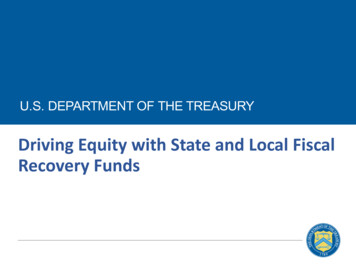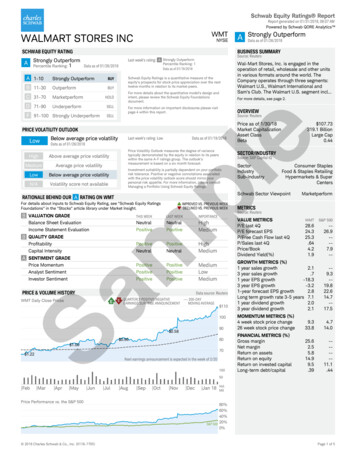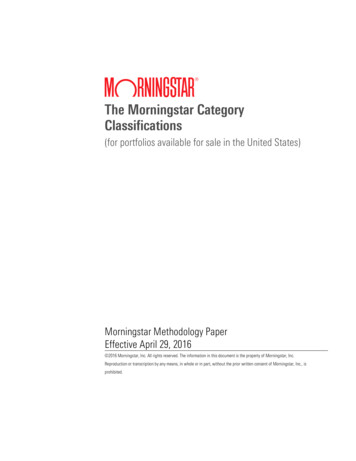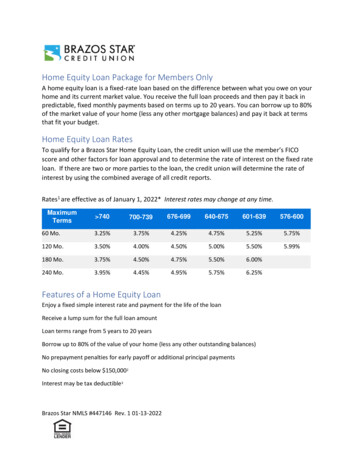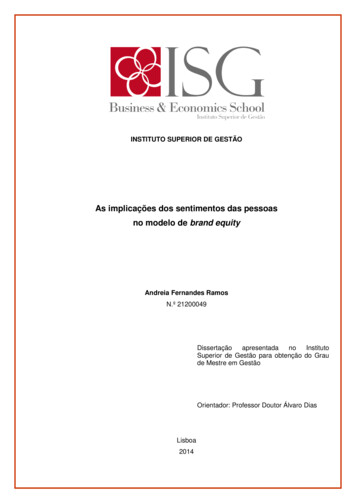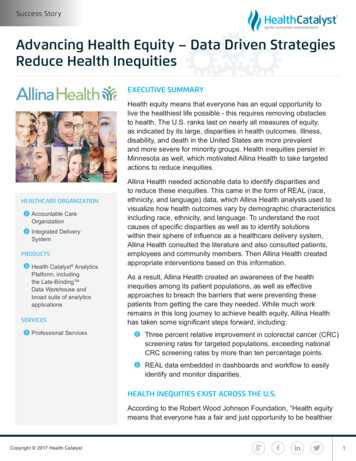
Transcription
Success StoryAdvancing Health Equity – Data Driven StrategiesReduce Health InequitiesEXECUTIVE SUMMARYHealth equity means that everyone has an equal opportunity tolive the healthiest life possible - this requires removing obstaclesto health. The U.S. ranks last on nearly all measures of equity,as indicated by its large, disparities in health outcomes. Illness,disability, and death in the United States are more prevalentand more severe for minority groups. Health inequities persist inMinnesota as well, which motivated Allina Health to take targetedactions to reduce inequities.HEALTHCARE ORGANIZATIONAccountable CareOrganizationIntegrated DeliverySystemPRODUCTSHealth Catalyst AnalyticsPlatform, includingthe Late-Binding Data Warehouse andbroad suite of analyticsapplicationsSERVICESProfessional ServicesAllina Health needed actionable data to identify disparities andto reduce these inequities. This came in the form of REAL (race,ethnicity, and language) data, which Allina Health analysts used tovisualize how health outcomes vary by demographic characteristicsincluding race, ethnicity, and language. To understand the rootcauses of specific disparities as well as to identify solutionswithin their sphere of influence as a healthcare delivery system,Allina Health consulted the literature and also consulted patients,employees and community members. Then Allina Health createdappropriate interventions based on this information.As a result, Allina Health created an awareness of the healthinequities among its patient populations, as well as effectiveapproaches to breach the barriers that were preventing thesepatients from getting the care they needed. While much workremains in this long journey to achieve health equity, Allina Healthhas taken some significant steps forward, including:Three percent relative improvement in colorectal cancer (CRC)screening rates for targeted populations, exceeding nationalCRC screening rates by more than ten percentage points.REAL data embedded in dashboards and workflow to easilyidentify and monitor disparities.HEALTH INEQUITIES EXIST ACROSS THE U.S.According to the Robert Wood Johnson Foundation, “Health equitymeans that everyone has a fair and just opportunity to be healthier.Copyright 2017 Health Catalyst1
We’ve learned that thereis a difference betweenequality—where everyoneis treated the same—and equity; providing ourpatients the level of supportthey need to be successful.By providing additionalsupport to address thebarriers, we are able toreduce health inequities.Jana Beckering, RNProject ManagerAllina Hospitals and ClinicsThis requires removing obstacles to health, such as poverty,discrimination, and their consequences, including powerlessnessand lack of access to good jobs with fair pay, quality education andhousing, safe environments, and health care.”1The U.S. ranks last on nearly all measures of equity because ofits large income-related differences in health outcomes.2 The mostcommon causes of illness, disability, and death in the U.S.—heartdisease, cancer, diabetes, and stroke—are more common and moresevere for minority groups.Health inequities persist in Minnesota as well, despite the efforts ofmany organizations and programs to improve health.3African-American and American Indian babies die in the firstyear of life at twice the rate of white babies.While infant mortality rates for all groups have declined, theinequity in rates has existed for over 20 years.The rate of HIV/AIDS among African-born persons is nearly 16times higher than among white, non-Hispanic persons.American Indian, Hispanic/Latino, and African-American youthhave the highest rates of obesity, and African-American andHispanic/Latino women in Minnesota are more likely to bediagnosed with later-stage breast cancer.Allina Health, a not-for-profit healthcare system with 12 hospitalsand 67 clinic sites and ambulatory care centers, is dedicated to theprevention and treatment of illness, and helping people live healthierlives in communities throughout Minnesota and western Wisconsin.HEALTH EQUITY PROBLEMS PERSIST IN MINNESOTAFor more than 15 years, Minnesota has tracked disparities inpopulations of color, American Indians, children, adolescents,immigrants and refugees, and lesbian, gay, bisexual, transgender,and queer (LGBTQ).In 2011, the state of Minnesota began requiring healthcare providersto collect race, ethnicity, and language (REAL) data. These datarevealed inequity. Available literature provided insight into severalvariables that contribute to these inequities:Health system issues related to the complexity of the system,how it has been poorly adapted to minority patients orthose with limited English proficiency, and how it has beendisproportionately difficult to navigate.Copyright 2017 Health Catalyst2
Care process issues related to care providers, includingstereotyping, the impact of race and ethnicity on decisionmaking, and clinical uncertainty due to poor communication.Patient-related issues including patient’s mistrust, pooradherence to treatment, and delays in seeking care.Allina Health began stratifying some of its clinical quality outcomesmetrics in 2013, revealing opportunities to close the gap amongstsome of its racial/ethnic minority patient populations. This stratifieddata demonstrated that serious health inequities persisted,motivating Allina Health to take targeted actions to reduce inequities.UNDERSTANDING CAUSES OF INEQUITY ENABLEDCUSTOMIZED INTERVENTIONSUsing data to identify inequitiesTo be successful in reducing inequities, Allina Health needed tounderstand the outcomes its patients were experiencing. For this,it needed data. Using the Health Catalyst Analytics Platform,including the Late-Binding Data Warehouse and a broad suite ofanalytics applications, Allina Health studied REAL data, and dataregarding country of origin, to begin understanding inequities.After standardizing data collection, categories of data, and methodsused to conduct the analyses, data analysts at Allina Health providedvisualizations of health outcomes by race, ethnicity, and language,and displayed the outcomes compared to the white, non-Hispanic/Latino, English-speaking population (see Figure 1).Analytics revealed that Allina Health had opportunities to reducehealth inequities, including improving colorectal cancer screening(CRC) rates. Allina Health developed a multi-level work plan toincrease CRC screening rates among speakers of Somali, Hmong,Spanish, Arabic, and Russian languages; as well as Hispanic/Latino,American Indian, African-American, and Native Hawaiian and otherPacific Islander populations. The goal was to achieve a screeningrate comparable to the white, non-Hispanic/Latino, English-speakingpatients, incrementally closing the gap.Allina Health recognized that despite having REAL data, itsunderstanding of patients’ needs and perceptions regarding CRCscreening was likely incomplete. The REAL data, and data in theEHR, does not include important data regarding other factors thatinfluence health, such as patient values and beliefs about healthcareCopyright 2017 Health Catalyst3
Figure 1. Sample health equity data – REAL data and comparison population.and specific healthcare interventions, housing stability, financialresource strain, culture, gender identity, food insecurity, socialconnectedness, and other social determinants of health.Using literature and engagement to understand disparitiesTo develop a complete picture and understand root causescontributing to lower CRC screening rates, Allina Health researchedavailable evidence about how to increase screening rates in minoritypopulations, which increased its understanding of barriers, andactivities to remedy those barriers.Allina Health used focus groups with its certified medical interpreters,to gain additional understanding of various patient populations. AllinaHealth learned about values, beliefs, and barriers that might impedepatients from completing the recommended CRC screening:The subject matter may be perceived as shameful or sexualby some.Screening may be an unfamiliar concept. In some cultures,the word “screening” simply doesn’t exist. Phrases suchas “looking for cancer” may be more effective.Copyright 2017 Health Catalyst4
We’ve developed consistentdata categories andstandard, shared methodsfor analyzing our data. Thishas improved our ability touse data and analytics toidentify, and then work toreduce, health inequities.Mollie O’Brien, MADirector, Health EquityAllina HealthConcerns regarding discomfort with the procedure, based onprior healthcare experiences in a patient's home countrywhere pain medication was not used.Basic needs—food, housing, bills—may take priority overpreventive health treatment.Discomfort with opposite sex providers and interpreters.Belief that cancer is God’s will, and that people should notintervene or try to prevent it.Intervening and monitoring the effectiveness of interventionsWith improved understanding of the needs of the variouspatient populations, Allina Health developed and implemented awork plan to improve CRC screening rates, which includes thefollowing interventions:The health system mails patients home testing/screening kits.The health system uses culturally tailored education materials,instructions, and frequently asked question documents, allwritten in the patient’s primary language.Patients who do not complete the CRC screening after theinitial offering receive a second kit and a phone call in theirown language to remind them to complete the test. To conveythe benefit of completing the CRC screening, and to addressquestions a patient might have about the test.Care guides employed by Allina Health connect with patientsand work through barriers, including non-medical healthrelated social needs and transportation needs, to increasethe patient’s understanding of screening goals and screeningoptions. Allina Health harnesses the power of community,such as running colorectal cancer screening social mediacampaigns designed to better engage African-American andSpanish-speaking patients, a colorectal cancer screening videofor Somali patients, and a skills-based employee-volunteerismcampaign that invites Allina Health employees to talk to theirsocial networks about the why and how to get screened forcolorectal cancer. The social media campaigns and videosuse evidence-informed communication to most effectivelyreach the community of interest. Allina Health also its websiteto communicate the importance of CRC screening and isinvestigating the use of newspaper, radio, and television.Through its analytics application, Allina Health is able tomonitor the effectiveness of its interventions on the populationsat highest risk for the poorest screening rates (see Figure 2).Copyright 2017 Health Catalyst5
FIGURE 2. CRC SCREENINGRATE AMONG WHITE/NON-HISPANIC/LATINO,ENGLISH-SPEAKINGPATIENTS COMPARED TOCRC SCREENING RATEAMONG BLACK OR AFRICANAMERICAN PATIENTS.121 Filters are divided intogroups for comparingpatient populations.2 Visual display of outcomesfor comparison groups.Figure 2. CRC screening rate among white/Non-Hispanic/Latino,English-speaking patients compared to CRC screening rate amongblack or African-American patients.RESEARCH AND DATA-DRIVEN RESULTSAllina Health’s data-driven approach to reducing health inequitiesdemonstrated effectiveness through customized interventions. Thesystem increased its understanding of health equity, improved itsawareness of where inequities existed, and confirmed an effectiveapproach for reducing them resulting in:Three percent relative improvement in colorectal cancer (CRC)screening rates for targeted populations, exceeding nationalCRC screening rates by more than ten percentage points.REAL data embedded in dashboards and workflow to easilyidentify and address disparities.WHAT’S NEXTThe integration of demographic filters into all of Allina Healthdashboards has enabled the organization to identify opportunitiesto address health inequities in many areas, including:Primary care—diabetes, hypertension, asthma, pediatricimmunizations, cancer screening, no show-rates, primary careprovider assignment.Obstetric care—breastfeeding, transfusion, post-partumhemorrhage, pre-term delivery, fetal loss.Copyright 2017 Health Catalyst6
Mental health—depression screening, depression claims,outpatient follow-up.Emergency care—ED utilization, wait times, use of restraints/seclusions.Hospital care—potentially avoidable hospitalizations fordiabetes, HF, asthma, COPD, pneumonia and depression,readmissions, high-tech imaging claims.Pharmacy utilization.The organization will continue to build capacity for the organizationto understand the root causes of the inequities and to take action.Allina Health is sharing the learnings from this important work andcreating additional organizational capacity to reduce health inequitiesthroughout the organization, integrating health equity data into all itsquality improvement efforts.REFERENCES1. Braverman, P., Arkin, E., Orleans, T., Proctor, D., & Plough, A. (2017).What is health equity: And what difference does a definition make? RobertWood Johnson Foundation. Retrieved from hat-is-health-equity-.html2. National Quality Forum. (2008). Closing the disparities gap in health qualitywith performance measurement and public reporting. Retrieved from losing the Disparities Gapin Healthcare Quality With Performance Measurement and PublicReporting.aspx3. Minnesota Department of Health, Commissioner’s Office. (2014). Advancinghealth equity in Minnesota: Report to the legislature. Retrieved from y/ahe leg report 020414.pdfCopyright 2017 Health Catalyst7
ABOUT HEALTH CATALYSTHealth Catalyst is a next-generation data, analytics, and decisionsupport company committed to being a catalyst for massive,sustained improvements in healthcare outcomes. We are theleaders in a new era of advanced predictive analytics for populationhealth and value-based care. with a suite of machine learningdriven solutions, decades of outcomes-improvement expertise, andan unparalleled ability to integrate data from across the healthcareecosystem. Our proven data warehousing and analytics platformhelps improve quality, add efficiency and lower costs in support ofmore than 85 million patients and growing, ranging from the largestUS health system to forward-thinking physician practices. Ourtechnology and professional services can help you keep patientsengaged and healthy in their homes and workplaces, and we canhelp you optimize care delivery to those patients when it becomesnecessary. We are grateful to be recognized by Fortune, Gallup,Glassdoor, Modern Healthcare and a host of others as a BestPlace to Work in technology and healthcare.Visit www.healthcatalyst.com, and follow us on Twitter, LinkedIn,and Facebook.Copyright 2017 Health Catalyst
including the Late-Binding Data Warehouse and a broad suite of analytics applications, Allina Health studied REAL data, and data regarding country of origin, to begin understanding inequities. After standardizing data collection, categories of data, and methods used to conduct the analyses, data analysts at Allina Health provided
